Weapons Labs Are Attacking Pollution
- Share via
ALBUQUERQUE, N.M. — The silver trough, as long as a football field, was developed to harness the sun and help wean the nation off imported oil. For years, it stood abandoned in the desert, an obsolete relic of the 1970s.
Now, in another time and another growing national crisis, researchers at Sandia National Laboratories have dusted off their sophisticated solar panels and put them back to work.
This time, the panels are helping to scrub the environment. Sandia scientists believe they’ve found an efficient way to use solar power to break down toxic waste, help clean up polluted dumps and cleanse contaminated water tables.
“We’re just helping nature, that’s all. There’s nothing artificial about this,” said Virgil Dugan, Sandia’s director of advanced energy technology.
Solar research is just one area where scientists at Sandia, one of the nation’s three nuclear weapons laboratories, are finding ways to help with growing environmental problems.
As the need for ever-improved nuclear weapons lessens, the laboratories are directing their technological might to greater peacetime use.
With expertise developed for weapons programs and Army machinery, “smart” robots are hurriedly being assembled to clean out highly radioactive and toxic chemical waste at Department of Energy weapons plants across the country.
“It’s the same technology (that goes into weapons programs), even though it seems there are two different applications,” said Pat Eicker, manager of robotic science and technology at Sandia.
In the case of the abandoned solar collector, scientists realized that they might be able to run contaminated water, such as polluted ground water, through the sunlight-focusing machine and use its power to help break down organic toxic waste.
The contaminated water is mixed with a catalyst--titanium dioxide--and pumped through a clear tube in the center of the long, parabolic solar trough.
The tube glows like Darth Vader’s sword as sunlight activates the titanium dioxide, which frees an electron. The electron grabs onto organic material, in this case, the contaminates, and breaks them down into water, carbon dioxide and a mild, harmless acid.
Until a full-scale experiment last June, scientists weren’t sure if the solar machine would cause complete destruction of the pollutants. It did.
“You can drink the water that comes out at the end,” said Mike Prairie, a senior technical staff member on the solar project.
“We never did this before because nobody thought of it before,” Dugan said. “Some might say it’s a breakthrough. I think of it as an engineering advancement.”
Companies are lining up to learn more about Sandia’s gadget, Dugan said. The laboratory plans to have a trial system out in a year, and Dugan thinks the system is about four years away from commercial use.
Sandia has been testing the system with water contaminated by trichloroethylene, a common degreasing substance that contaminates ground water. Scientists believe the system will also work on PCBs, dioxins, pesticides, dyes, solvents and other organic, or carbon-based, materials.
The solar panels won’t help with the problem of nuclear waste, however, because that is inorganic.
Companies must now package their toxic waste and ship it to dump sites or incinerators. The solar system might be economical enough to allow even small firms to have on-site waste treatment systems, which also may be portable, Dugan said. It will probably be more efficient, and cheaper, than current ground water purification systems, he said.
Sandia’s robotics researchers began eight years ago to find ways to use machines for the sometimes dangerous work of building nuclear weapons and handling plutonium and other hazardous parts.
Already the lab has created a “smart” manufacturing system that will help automate some production in weapons plants. It has also designed wheeled robotic vehicles for the Army.
More to Read
Sign up for Essential California
The most important California stories and recommendations in your inbox every morning.
You may occasionally receive promotional content from the Los Angeles Times.













